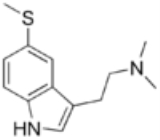
5-MeS-DMT
Encyclopedia
5-MeS-DMT, or 5-methylthio
-N,N-dimethyltryptamine
, is a lesser-known psychedelic drug
. It is the 5-methylthio
analog
of DMT
. 5-MeS-DMT was first synthesized by Alexander Shulgin
. In his book TiHKAL
(Tryptamines I Have Known and Loved), the minimum dosage is listed as 15-30 mg. The duration listed as very short (less than one hour), just like its analog, DMT. 5-MeS-DMT produces similar effects to DMT, but weaker. Shulgin describes his feelings while on a low dose of this drug as "pointlessly stoned", although at a higher dose of 20 mg he says it is "quite intense" and suggests that a higher dose still might have full activity. Very little data exists about the pharmacological properties, metabolism, and toxicity of 5-MeS-DMT.
Thio
The prefix thio-, when applied to a chemical, such as an ion, means that an oxygen atom in the compound has been replaced by a sulfur atom. This meaning is especially valid in organic chemistry. For example, the word ether refers to an oxygen-containing compound having the general chemical...
-N,N-dimethyltryptamine
Tryptamine
Tryptamine is a monoamine alkaloid found in plants, fungi, and animals. It is based around the indole ring structure, and is chemically related to the amino acid tryptophan, from which its name is derived...
, is a lesser-known psychedelic drug
Psychedelics, dissociatives and deliriants
This general group of pharmacological agents can be divided into three broad categories: psychedelics, dissociatives, and deliriants. These classes of psychoactive drugs have in common that they can cause subjective changes in perception, thought, emotion and consciousness...
. It is the 5-methylthio
Thio
The prefix thio-, when applied to a chemical, such as an ion, means that an oxygen atom in the compound has been replaced by a sulfur atom. This meaning is especially valid in organic chemistry. For example, the word ether refers to an oxygen-containing compound having the general chemical...
analog
Analog (chemistry)
In chemistry, a structural analog , also known as chemical analog or simply analog, is a compound having a structure similar to that of another one, but differing from it in respect of a certain component. It can differ in one or more atoms, functional groups, or substructures, which are replaced...
of DMT
Dimethyltryptamine
N,N-Dimethyltryptamine is a naturally occurring psychedelic compound of the tryptamine family. DMT is found in several plants, and also in trace amounts in humans and other mammals, where it is originally derived from the essential amino acid tryptophan, and ultimately produced by the enzyme INMT...
. 5-MeS-DMT was first synthesized by Alexander Shulgin
Alexander Shulgin
Alexander "Sasha" Theodore Shulgin is an American pharmacologist, chemist, artist, and drug developer.Shulgin is credited with the popularization of MDMA, commonly known as ecstasy, in the late 1970s and early 1980s, especially for psychopharmaceutical use and the treatment of depression and...
. In his book TiHKAL
TiHKAL
TiHKAL: The Continuation is a 1997 book written by Alexander Shulgin and Ann Shulgin about a family of psychoactive drugs known as tryptamines. A sequel to PiHKAL: A Chemical Love Story, TiHKAL is an acronym that stands for Tryptamines I Have Known and Loved.-Content:TiHKAL, much like its...
(Tryptamines I Have Known and Loved), the minimum dosage is listed as 15-30 mg. The duration listed as very short (less than one hour), just like its analog, DMT. 5-MeS-DMT produces similar effects to DMT, but weaker. Shulgin describes his feelings while on a low dose of this drug as "pointlessly stoned", although at a higher dose of 20 mg he says it is "quite intense" and suggests that a higher dose still might have full activity. Very little data exists about the pharmacological properties, metabolism, and toxicity of 5-MeS-DMT.
See also
- TryptamineTryptamineTryptamine is a monoamine alkaloid found in plants, fungi, and animals. It is based around the indole ring structure, and is chemically related to the amino acid tryptophan, from which its name is derived...
- DimethyltryptamineDimethyltryptamineN,N-Dimethyltryptamine is a naturally occurring psychedelic compound of the tryptamine family. DMT is found in several plants, and also in trace amounts in humans and other mammals, where it is originally derived from the essential amino acid tryptophan, and ultimately produced by the enzyme INMT...
- Psychedelics, dissociatives and deliriantsPsychedelics, dissociatives and deliriantsThis general group of pharmacological agents can be divided into three broad categories: psychedelics, dissociatives, and deliriants. These classes of psychoactive drugs have in common that they can cause subjective changes in perception, thought, emotion and consciousness...

